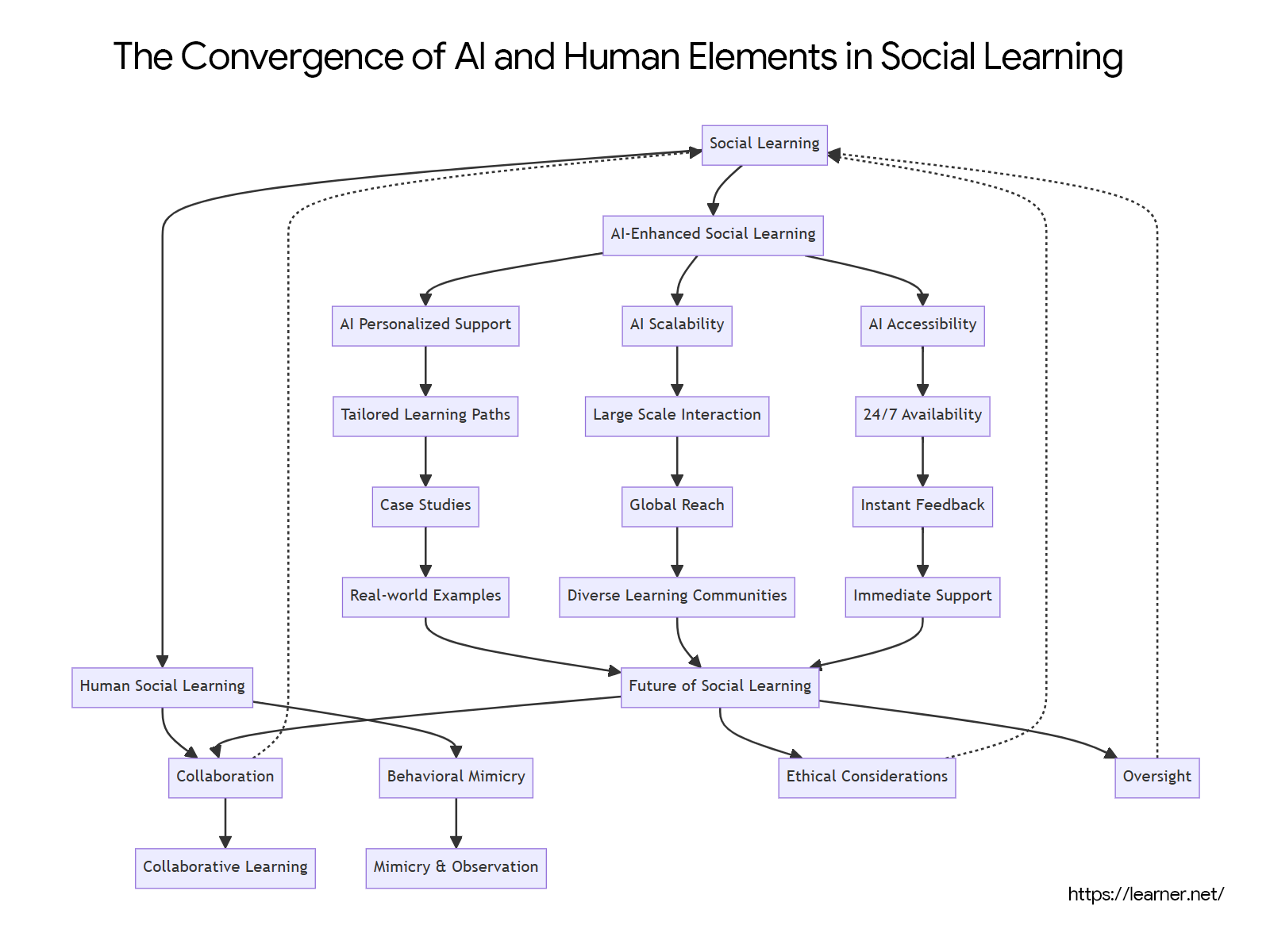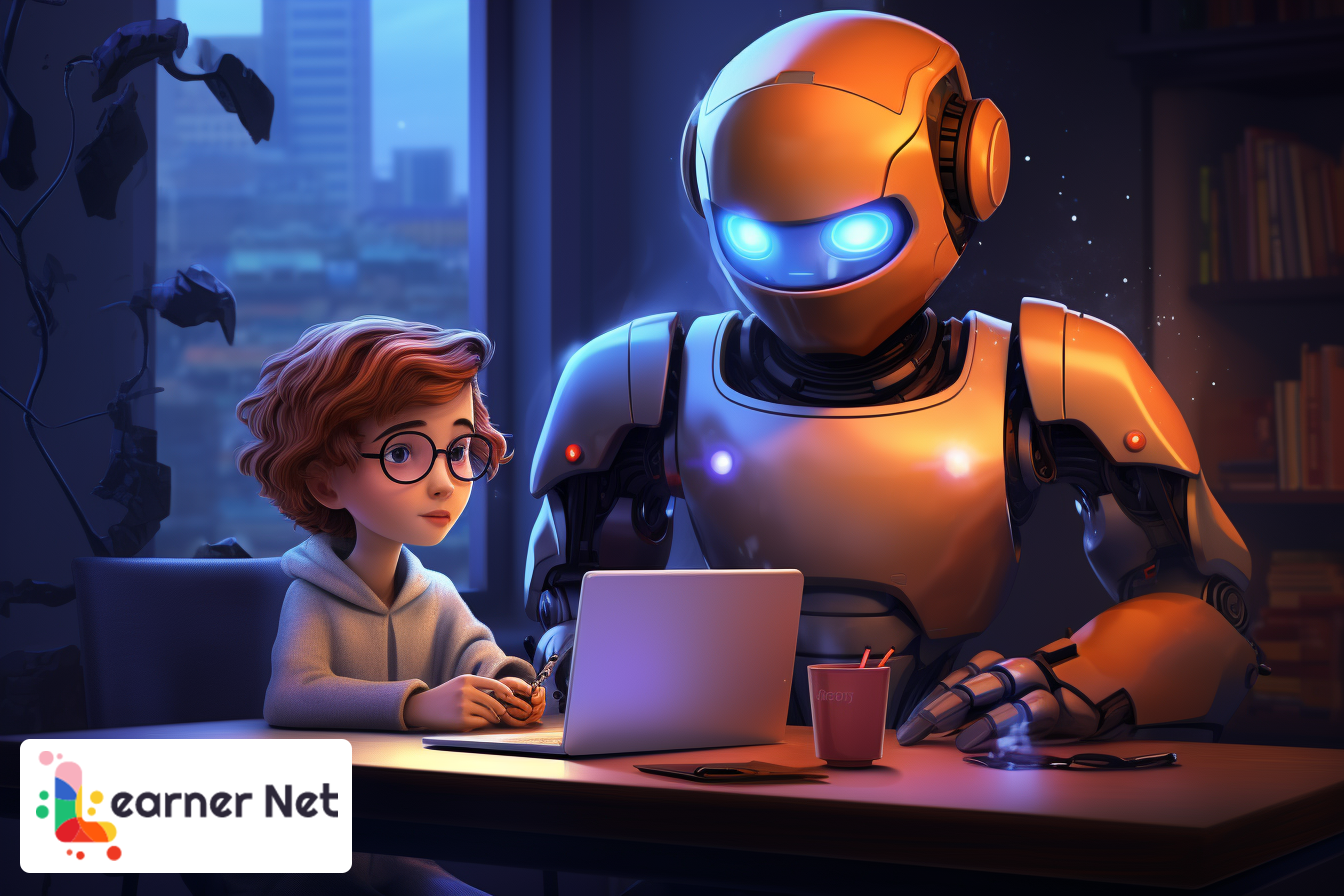Introduction
In the education domain, social learning has long been the vibrant thread that weaves together the process of acquiring knowledge through shared experiences. Dialogue, collaboration, and the subtle art of observation have traditionally driven the collective quest for learning. We now stand on the brink of a paradigm shift with AI, which can potentially redefine the boundaries of educational engagement.
This fusion of AI with social learning is not about replacing the human involvement of fostering growth and understanding. Instead, it’s about augmenting the reach and depth of every educational encounter.
In this article, we’ll explore how AI can amplify the foundational elements of social learning, transforming not just how we learn, but also the very fabric of knowledge sharing.
AI-Enhanced Social Learning
The traditional classroom’s buzz—groups of students huddled over shared tasks, the exchange of ideas, the collective ‘aha’ moments—has found a new participant, Artificial Intelligence. Here’s how AI is enhancing the pillars of social learning:
- AI Personalized Support:
- AI tailors the learning experience to individual needs. Unlike the one-size-fits-all approach, AI analyzes each student’s performance, learning pace, and preferences, crafting a personalized learning journey.
- It provides real-time assistance. Students no longer need to wait for office hours or the next class session for answers. AI offers immediate responses to queries, ensuring that learning never hits a pause.
- AI Scalability:
- The scalability of AI means that no classroom is too large, no forum too crowded. AI can simultaneously engage with multiple students, providing each with the sense of a one-on-one interaction.
- This scalability extends to content delivery. AI systems can disseminate information, manage assignments, and track progress across vast networks of learners with ease.
- AI Accessibility:
- Learning knows no downtime with AI. It offers 24/7 availability, breaking down the barriers of time zones and schedules.
- Accessibility also means inclusivity. AI tools are being designed to cater to a diverse range of learning abilities, ensuring that education is equitable and accessible to all.
Figure 1: Navigating the Future of Education: The AI Revolution in Social Learning
In the next section, let us explore how AI is not just a tool for efficiency but a catalyst for a more interactive and inclusive learning environment.
The Synergy of AI and Collaborative Learning
Collaboration in education is a crucible for cultivating critical thinking, empathy, and the collective construction of knowledge. The traditional classroom thrives on these group dynamics, where students engage, debate, and challenge one another, fostering a rich learning environment.
AI’s foray into collaborative learning is akin to introducing a new, indefatigable member to the study group. This AI member is equipped with a vast, ever-updating repository of information and the capability to offer personalized guidance. It’s here that AI personalized support shines, providing tailored resources and scaffolding to students based on their individual contributions and interactions within the group. It’s a digital facilitator that ensures every group member’s needs are met, and no one falls behind.
Moreover, AI’s role in mimicry and observation offers a unique perspective. By analyzing patterns in student discussions and behaviors, AI builders can offer insights and prompts that steer the conversation toward deeper understanding and unexplored angles. This is not about AI mimicking human interaction, but rather, about enhancing the group’s ability to reflect and learn from one another.
The impact is profound; it extends beyond the mere provision of information, by understanding the group dynamics and individual learning paths. The visual guide in Figure 1 illustrates the integration of AI into the core of social learning, showing a symbiotic relationship where technology and human insight meet to foster an enriched learning environment.
Figure 2. The Convergence of AI and Human Elements in Social Learning
In the context of language learning, the collaborative environment is essential. It’s where learners practice new vocabulary, grapple with grammar, and, most importantly, engage in the kind of spontaneous dialogue that cements fluency.
Imagine a scenario where language learners are discussing a novel. Each student brings their interpretation to the table, but they also bring varying levels of language proficiency. An AI Assistant, drawing from its vast database of linguistic patterns and educational material (AI Personalized Support), can offer real-time suggestions for more accurate or nuanced expressions. It can correct grammatical errors on the fly and even propose alternative sentence structures to better convey a student’s point, all without interrupting the flow of conversation.
The AI’s ability to engage in Mimicry & Observation allows it to understand each learner’s unique challenges and progress. It observes how students apply new words in context, how they construct sentences, and how they react to corrections. With this data, the AI can model language use that’s just a step ahead of the learner’s current level, pushing them towards improvement. It can also provide personalized recap sessions after group activities, reinforcing what was learned through collaboration.
Furthermore, the AI’s role in Collaborative Learning is not limited to direct language practice. It can organize role-playing scenarios, set up debates, and facilitate group projects that require learners to apply their language skills in diverse, context-rich situations. This not only solidifies linguistic knowledge but also enhances cultural understanding and soft skills like negotiation and persuasion.
In the subject of mathematics, consider a group of students tackling statistical analysis. As they work through data sets, the AI Assistant can provide real-time, data-driven insights, guiding students to discern patterns and correlations that might not be immediately apparent. It can challenge students with predictive questions, encouraging them to apply statistical concepts to real-world scenarios, thus deepening their understanding of abstract theories.
The AI’s capacity for Mimicry & Observation allows it to track the problem-solving strategies of each student, offering customized hints that nudge them toward more efficient methods or alternative solutions. This individualized attention ensures that while the collaborative effort drives the session, each student’s personal growth is also catered to.
In the sciences, collaboration often takes place within the context of experiments and research projects. Here, the AI’s role extends into the laboratory, where it serves as a digital lab assistant. Through AI Scalability, it can manage and analyze vast amounts of experimental data, providing students with the kind of immediate feedback and pattern recognition that would be impossible at a human scale.
Imagine a group of students conducting a series of chemistry experiments. The AI Assistant can monitor the progress of each experiment in real-time, alerting students to any anomalies in their reactions or suggesting adjustments to their methodology based on a database of chemical properties and reaction outcomes. This not only prevents missteps but also instills a deeper understanding of the scientific process.
By transcending physical limitations, AI fosters inclusive learning environments where diversity is celebrated, and education is accessible to all, regardless of location or time zone. The immediate feedback loop established by AI is not merely a convenience; it’s a catalyst for continuous improvement and accelerated learning within a social context.
By integrating these AI-driven insights and support mechanisms, learning becomes a more dynamic, responsive, and ultimately effective process. As we pivot to consider the ethical framework that must underpin this technological integration, it’s essential to remember that a key value of AI in social learning lies in its ability to enhance human connection.
Ethical Considerations and the Role of Oversight in AI-Assisted Learning
As we embrace AI’s Assistance in education, it’s crucial to navigate the ethical landscape with as much care as we do the technological one. The deployment of AI Assistants by tutors raises significant ethical questions that must be addressed to maintain the integrity of the educational experience.
- Data Privacy: When tutors deploy AI Assistants, the privacy of student data is paramount. Educators and institutions must ensure that all interactions with AI Assistants are compliant with data protection regulations. Students and parents should be informed about what data is collected and how it is used.
- Transparency: There must be clarity regarding the AI Assistant’s functionality. Students should know when they are interacting with an AI and understand the extent of its capabilities and limitations.
- Bias and Fairness: AI Assistants must be scrutinized for biases that may arise from their training data. It’s essential to ensure that the AI does not perpetuate stereotypes or provide advantages to certain student demographics over others.
- Access and Inclusivity: AI Assistants should be accessible to all students, including those with disabilities. This means considering diverse needs in their design and implementation.
- Accountability: When AI Assistants are used to supplement or deliver educational content, questions of accountability arise. Who is responsible for the accuracy of the information provided by the AI? Tutors and institutions must establish clear guidelines for oversight.
- Intellectual Property: The content created by AI Assistants, based on inputs from various educational materials, may raise intellectual property concerns. It’s important to define who owns the content generated by the AI and how it can be used.
The role of human oversight will become increasingly significant. Tutors and educational institutions should take care to adopt platforms that operate within these ethical boundaries and serve the intended educational purposes. The integration of AI into social learning is not just about technological advancement but also about fostering an environment of trust and responsibility.
Conclusion
In this article, we’ve navigated the traditional frameworks of collaboration and behavioral mimicry—cornerstones of human learning that have thrived in classrooms and study groups for generations. We’ve seen how AI, with its personalized support, scalability, and round-the-clock availability, doesn’t replace these foundations but rather strengthens and extends them.
The mimicry and observation that are so natural in human learning are mirrored in AI’s ability to adapt and respond to each learner’s needs. The global reach of AI is able to break down barriers and time zones to bring learners together, and provide instant feedback that was formerly impossible in distant learning scenarios.
As we harness AI to break new ground in education, we must tread thoughtfully, considering the ethical implications and ensuring that human oversight remains at the helm. The collaboration between educators, learners, and technologists is pivotal as we shape an educational future that is inclusive, equitable, and above all, human.
About Learner Net
Learner Net is a platform where the pursuit of knowledge meets the cutting edge of technology. At its core, Learner Net is dedicated to fostering an environment where learning is not just accessible but also adaptive, personalized, and engaging.
With a suite of tools designed to connect tutors, students, and parents, Learner Net transcends traditional educational boundaries. It offers a dynamic online arena where one-to-one tutoring, group classes, and self-paced learning coalesce.
Learner Net’s vision is clear: to harness the potential of AI to enrich the educational journey. By integrating AI Assistants into the learning experience, the platform ensures that every user — be it a tutor sharing expertise, a student seeking understanding, or a parent nurturing growth — will have a digital companion on their educational odyssey.
As Learner Net continues to evolve, it remains steadfast in its mission: to empower learners and educators through technology, to foster a community of shared knowledge, and to pave the way for a future where education is not just a privilege but a lifelong adventure for all.






There are no reviews yet.